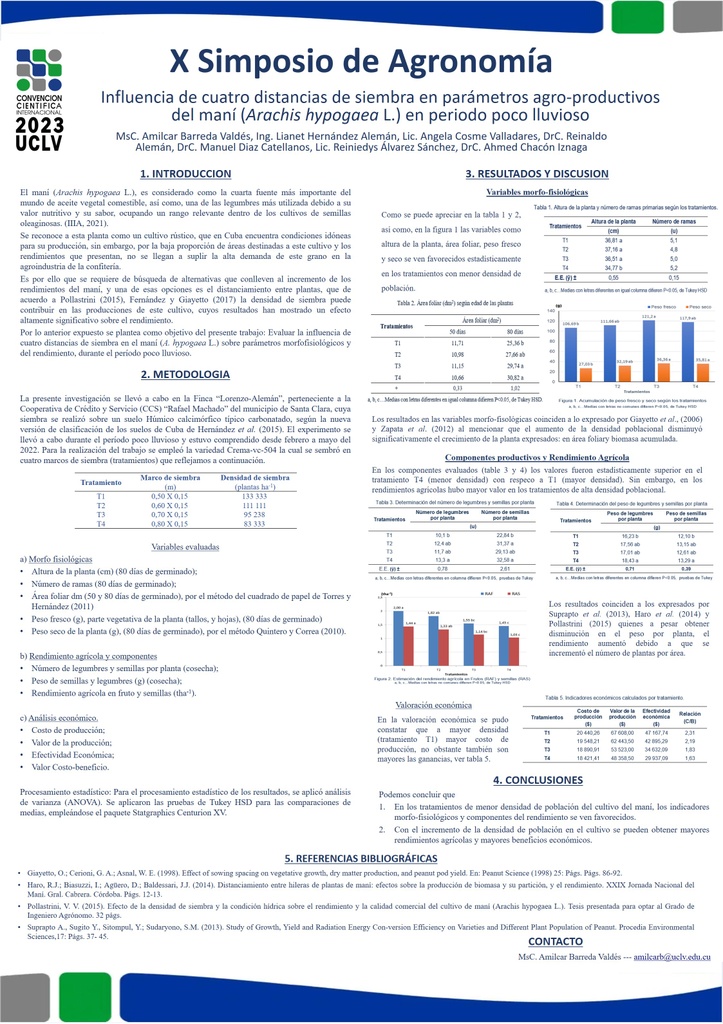Executive Secretary

IX Conferencia Científica Internacional sobre Desarrollo Agropecuario y Sostenibilidad
X Simposio de Agronomía

Resumen
Con el objetivo de evaluar la influencia de cuatro distancias de siembra sobre el desarrollo del maní (Arachis hypogaea L.), durante el periodo poco lluvioso, se realizó una investigación en la Finca “Lorenzo-Alemán”, perteneciente a la Cooperativa Crédito y Servicio (CCS) “Rafael Machado” ubicado en la comunidad Hatillo en Santa Clara. La investigación se desarrolló en los meses de enero a mayo del 2022, en condiciones de suelo Húmico calcimórfico típico carbonatado, con la variedad de maní Crema-VC-504. Para la investigación se conformó un diseño experimental con cuatro tratamientos diferenciándose en la distancia entre surcos de 0.50 m (T1), 0.60 m (T2), 0.70 m (T3) y 0.80 m (T4) (según el orden de mayor a menor densidad), en un esquema de campo de parcelas divididas con tres réplicas por tratamiento. Fueron evaluados indicadores morfofisiológicos, su rendimiento y se realizó una valoración económica. Como resultado se obtuvo que en el tratamiento T4 (menor densidad) se alcanzan los mayores valores de área foliar, peso fresco y seco, potencial fotosintético, número y peso de legumbres y semillas por planta, sin embargo, fue el tratamiento de mayor densidad (T1) quien se destacó en cuanto a Índice de área foliar y los rendimientos agrícolas en legumbres y semillas por área. La valoración económica corroboró que la distancia empleada en el tratamiento (T1) de mayor densidad de población, influyó en mayores costos productivos e ingresos y la obtención de mejores beneficios.
Abstract
In order to evaluate the influence of four planting distances on the development of peanuts (Arachis hypogaea L.), during the dry season, an investigation was carried out at the "Lorenzo-Alemán" Farm, belonging to the Credit and Service Cooperative. (CCS) “Rafael Machado” located in the Hatillo community in Santa Clara. The research was carried out in the months of January to May 2022, in typical carbonate calcimorphic humic soil conditions, with the Crema-VC-504 peanut variety. For the investigation, an experimental design was formed with four treatments, differing in the distance between furrows of 0.50 m (T1), 0.60 m (T2), 0.70 m (T3) and 0.80 m (T4) (according to the order from highest to lowest density). ), in a split-plot field scheme with three replicates per treatment. Morpho-physiological indicators and their performance were evaluated and an economic assessment was made. As a result, it was obtained that in the T4 treatment (lower density) the highest values of leaf area, fresh and dry weight, photosynthetic potential, number and weight of legumes and seeds per plant were reached, however, it was the treatment with the highest density (T1) who stood out in terms of leaf area index and agricultural yields in legumes and seeds per area. The economic valuation corroborated that the distance used in the treatment (T1) of greater population density, influenced higher production costs and income and the obtaining of better benefits.
Sobre el ponente

MsC. Amilcar Barreda Valdés

Discussion

